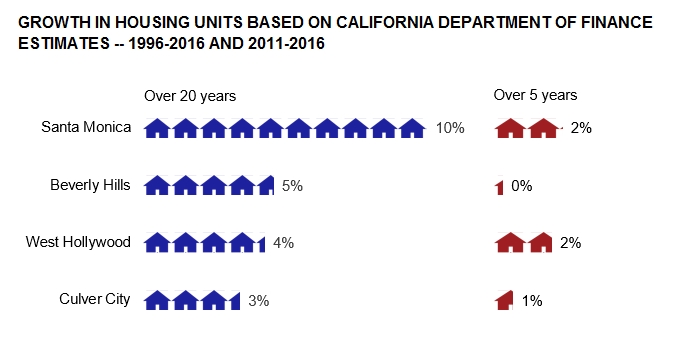
Santa Monica’s housing supply has grown faster than West Hollywood’s, though West Hollywood may have more units in the short-term pipeline. That is according to a follow-up analysis by WeHo by the Numbers. The analysis looked only at the number of housing units and did not consider affordability.
The California Department of Finance estimates the number of housing units in each city. The chart above shows the percentage growth in their estimates over a 20-year period (1996-2016) and a more recent 5-year period (2011-2016). The growth represents new units built minus any demolished or otherwise removed from the housing supply.

Santa Monica led the way with 10% growth in the number of housing units over the last 20 years. Housing in Beverly Hills (5%), West Hollywood (4%) and Culver City (3%) grew at less than half that rate.
More recently, West Hollywood’s five-year housing growth rate (2%) was about the same as Santa Monica’s. Housing in Culver City and Beverly Hills grew less than 1%.
How are the housing stock and growth split among the four cities? West Hollywood had 25,127 housing units as of January, 2016. That was almost a quarter of the total for the four cities. Santa Monica had 52,082, which was close to half. Culver City had 17,587 and Beverly Hills had 16,444.
The 20 years of housing growth was split up differently. Santa Monica had less than half of the housing stock but two-thirds of the growth. West Hollywood had almost a quarter of the housing stock but only 15% of the growth.
The state’s estimates don’t include housing completed this year or still in the pipeline. West Hollywood probably has a much bigger share of those new units, based on building permits issued since 2014. To find out how big a share, please see the WeHo by the Numbers analysis, How much has housing in West Hollywood grown compared to nearby cities?

Woody McBreairty for city council!!! I’m in!!!
Guys…even if we built a huge Park La Brea in West Hollywood city limits…it wouldn’t affect rental prices. The price increase is evened out over the entire Southern CA area. From the Valley all the way south to San Diego. To get rent prices lower you need more single family homes built so those becomes affordable and only then rent prices will come down. Its not just a Weho thing. Its a CA real estate thing. However you can build more low-income buildings that will help the folks who make less than 46k. (Yes..that is considered low income now). But… Read more »
Exactly Woody!!! Thank you!!!
Woody, yes, those cities have less people per square mile. And that is why so many developments are growing upwards (multiple stories). Which many NIMBYs oppose. That is the only direction West Hollywood can grow in, just like other dense cities before it. Robert, your idea is noble, and I agree with it, but this question of adding more “affordable units….” how do we achieve that? Developers are going to build what makes them the most $$. The city might be able to provide some sort of incentives, but I’m not sure what they could do to take developers in… Read more »
@Woody McBreairty McBreairty, Slower growth will mean even higher rental rates for West Hollywood. The existing additions of housing stock are nice but very few people can afford them. What West Hollywood needs is more growth but not of luxury apartment buildings. Midrange and low income housing for existing residents is in short supply. Adding more buildings in the “affordable” category would help alleviate the needs of West Hollywood residents while also helping to slow the rise of rental prices in the city. If West Hollywood becomes just another wealthy enclave like Santa Monica and Beverly Hills it will lose… Read more »
Not figured into the equation is the fact that Santa Monica is 8.43 sq. mi. & has a population of about 98,000. Culver City is 5 sq. mi. & has a population of approx 38-40 thousand, Beverly Hills is 5.71 sq. mi & a population 34,000, roughly the same as West Hollywood’s population in 1.9 sq. mi. Those are areas 2.5 to 4.25 times larger than West Hollywood. The other 3 cities have more room to grow without squeezing out existing residents. West Hollywood is bursting at the seams & should look forward to less, slower & more controlled growth.
I don’t understand the purpose of these WeHo by the Numbers posts. You can make numbers say whatever you want them to say.
The purpose is to supply facts as a background for debates too often driven by erroneous assumptions. You can use the facts however you want. In this case, the facts make clear that West Hollywood has not grown massively in recent years, as many people claim. And they make clear that more development is on the books.